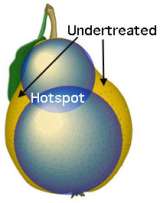Pituitary & Skull Base Tumor
About Gamma Knife
Find your care
We treat pituitary tumors using the latest innovations in minimally invasive procedures. To connect with an expert in the pituitary tumor program, call 310-825-5111.
General information
- The Stereotactic Radiosurgery Program at UCLA began 25 years ago when the Karolinska Institute of Stockholm, Sweden, donated one of two "Gamma Knife" units in existence for the purpose of collaborative research.
- Over the years, the UCLA radiosurgery team has worked with the most advanced radiotherapy units: Gamma Knife, LINAC Scalpel, XKnife and, more recently, the Novalis Shaped Beam Surgery system.
Radiation delivery systems
- Stereotactic radiosurgery versus radiotherapy:
- Stereotactic radiosurgery (SRS) delivers a high dose of radiation to a defined region in one treatment session.
- Stereotactic radiotherapy (SRT) delivers smaller doses of radiation over multiple sessions (usually 30 sessions over six weeks). This is called "fractionation," which means breaking up the large single dose into smaller fractions.
- Fractionation is less harmful to normal brain tissue. For example, if a tumor is near or touching a critical brain structure, such as the optic nerve or auditory nerve, SRT will substantially reduce the risk of radiation causing damage to that structure (blindness or hearing loss, respectively).
- SRT is not available using standard Gamma Knife systems, but is possible with the Novalis Shaped Beam Surgery system at UCLA.
- Any patient with a tumor near the optic nerve, the auditory nerve (acoustic neuromas), or the brainstem should consider seeking a second opinion prior to being treated with Gamma Knife.
- If you are unsure what type of stereotactic radiosurgery (or radiotherapy) is appropriate for you, UCLA physicians can provide a prompt film review or are always available for a second opinion.
- Conformal versus nonconformal radiation delivery:
- Brain tumors come in various shapes and sizes. Conformal delivery refers to the ability to "conform" to the shape of the tumor-delivering an even radiation dose to the entire tumor.
- The Gamma Knife is designed to deliver a spherical volume (a ball) of radiation. The size can be adjusted by the doctor. If a tumor is pear-shaped, for example, then two different sized spheres must be used with the Gamma Knife system to try to fill as much of the tumor volume as possible.
- The potential disadvantage of this nonconformal technique is that it is impossible to achieve an even dose of radiation. One or all of three things can happen:
- Some parts of the tumor do not receive the desired quantity of radiation because they are outside either sphere volume.
- Some parts of the tumor receive too much radiation because the spheres overlap.
- Some parts of normal brain structures are included in the high dose field.

- Nonconformal Radiation Delivery:
This illustration uses a pear to demonstrate the difficulty in obtaining conformal radiation planning using spherical targeting (Gamma Knife). In this example of a pear-shaped target, the two differently sized spherical doses cannot cover the entire target (undertreated areas) unless either the surrounding normal tissue receives a high dose of radiation, or there is a larger overlap of the spheres, which can cause complications due to an excessive radiation dose, or hotspot.
- The Novalis Shaped Beam Surgery system
- Designed to use advanced technology and computer algorithms to actively control the width and shape of the radiation beam during the treatment. Even very irregularly shaped tumors can be treated with very even, and therefore more effective and safer, radiation dosing using the Novalis system.
- For tumors that are spherical (such as many metastatic tumors), conformal treatment can be achieved with either the Gamma Knife or the Novalis systems. For oddly shaped tumors, however, the Novalis Beam Shaped Surgery system is advantageous.